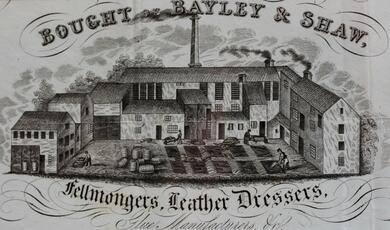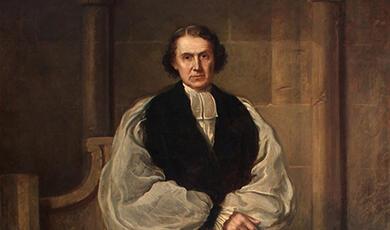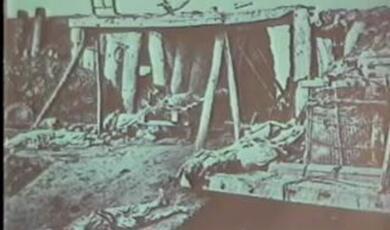The Death of Richard III: CSI Meets History
Share
- Details
- Transcript
- Audio
- Downloads
- Extra Reading
The skeleton of King Richard III was discovered beneath a Leicester car park in 2012. Modern forensic techniques were used to analyse the injuries to the skull, rib and pelvis.
The talk will discuss what computed and micro-computed tomography reveal about the injuries that were inflicted on him, and his probable cause of death; and how well the findings align with the historical record.
Download Transcript
King Richard III was killed at the Battle of Bosworth Field in Leicestershire on August 22nd, 1485. On September 4th, 2012, a skeleton was excavated in Leicester during a search for the location of the medieval friary of the Order of Friars Minors, Greyfriars. On 4th February 2013 the skeleton was confirmed to be that of the remains of King Richard III.
The skeleton was that of a male Caucasian, aged between 32-35 years, with pronounced scoliosis of the spine, injuries from battle, and carbon-dated to be from between 1450-1540. The skeleton’s mitochondrial DNA was found to trace back, through the female line, to match that of modern-day relatives descended from Richard’s mother, Cecily Neville. The skeleton was investigated using modern forensic techniques including conventional computed tomography (CT) and micro-computed tomography (µCT) in order to characterize the injuries and establish the probable cause of death.
This lecture will cover the ways in which the remains were analysed and discuss how modern forensic engineering science has provided insights into the analysis of the injuries.
A multi-disciplinary team worked on the project. The team that worked on the identification of the injuries to the skeleton included Dr Jo Appleby from the University of Leicester; Professor Guy Rutty of the East Midlands Forensic Pathology Unit; and Bob Woosnam-Savage of the Royal Armouries, Leeds, who provided expertise on the weapons which may have killed Richard. Others from the University of Leicester with key roles were Dr Richard Buckley and Matthew Morris who led the dig; Dr Turi King who performed the DNA analysis; and Professor Kevin Schurer who worked on the genealogy to identify modern-day relatives of Richard III. Others from Leicester and beyond contributed to the project and their work is referenced in the reading list below.
Work on finding the location of Greyfriars in Leicester was initiated by Philippa Langley of the Richard III Society. She was instrumental in obtaining permission from Leicester City Council to dig under the Car Park of the Social Services in Leicester.
The dig commenced on Friday 24th August 2012. After 6 hours and 43 minutes, a skeleton was located in Trench 1, with a leg bone sticking into the trench by about 50 cms. After further trenches were dug, it became apparent that it was likely that this skeleton was located in the choir of the church and was therefore likely to be someone of high status. Permission was granted from the Ministry of Justice to excavate the remains and at that point the trench was widened to reveal an articulated skeleton: i.e., the remains were laid out in the correct anatomical order. The skeleton was in good condition apart from missing its feet, that was likely caused by subsequent development of the site. There were obvious signs of trauma to the skeleton which were consistent with someone who had died in a battle. The skull of the skeleton was at a higher level than the rest of the remains, and there was an obvious curvature of the spine. Additionally, the hands were laid right over left over the right hip. This suggests that the hands were tied at the point at which the skeleton was laid in the grave although there was no evidence of any coffin, ties, or shroud, that would all have decayed if the skeleton had lain there a significant period of time.
The skeleton was taken to a lab at the University of Leicester where it was cleaned and photographed. The skeleton had equal-sized bones in the right and left arms and legs, showing no skeletal evidence of the withered arm that Shakespeare portrayed in his play Richard III, and additionally no evidence for a pronounced limp as depicted in the Laurence Olivier portrayal of him in the film.
Following an initial inspection, a number of imaging techniques were used to investigate the remains. Microscopes have been an important tool for forensic scientists and engineers, where they have been used since the late 19th century for studying trace evidence from blood, semen, soil, paint and for forensic engineering investigations in determining the origins of fracture or debris for example1. Modern microscopies use light or electrons to provide image surfaces of materials. These images can go from a magnification of a few times all the way to imaging the atoms of materials, depending on the type of microscope and the sample being studied. However, the images obtained are a 2D representation of the surface being studied.
X-rays were discovered in 1895 by Wilhelm Roentgen. One of the first images that was obtained using X-rays was of his wife Bertha’s hand. The contrast in the radiographic images arises from the fact that the X-ray beam is attenuated (stopped) by different amounts depending on the extent to which the beam is absorbed by the different parts of the object, so the image appears as different grey levels on the detector. The first clinical use of X-rays was in February 1896 when they were used to detect a fracture of the forearm. The first use of X-rays for forensic purposes followed quickly after, in May 1896, when Professor Arthur Schuster, a Professor at Owen's College (now part of the University of Manchester), imaged one of the bullets fired by Hargreaves Hartle, into the brain of his wife Elizabeth Ann Hartley at Nelson, Lancashire, on 23 April 1896.
2D X-ray images have been widely used but more recently techniques have been developed that allow images to be obtained that give a 3D representation of the object being studied. X-ray computed tomography (XCT) has been used for medical purposes since the early 1970s. In this technique, the patient lays on a table which passes through a ring that contains an X-ray source and a detector that are 180˚ apart. Multiple radiographic images of the area of interest are then taken whilst the detector and source rotate around the table. The multiple images are reconstructed using software to produce a 3D representation of the area imaged. The advantage of medical XCT is that the internal organs and bone structures can be imaged; however, the resolution and magnification of the images is limited by the fixed distances between the source and the detector. Also, care has to be taken not to provide too high a radiation dose to the patient.
X-ray CT has been widely used for forensic autopsies for a number of years4. Conventional medical XCT was therefore used to image the whole skeleton, which allowed the sex, age-range, and height of the skeleton to be determined, and revealed the injuries that would have led to death. The advantage of the patient being dead in this case was that higher radiation doses could be used than with a live patient, to obtain higher resolution images.
The skeleton was found to be that of an adult male with a gracile (slender) build. Detailed multi-factorial analysis of specific bones gave a narrow age range for the skeleton of between 30 and 34. (Richard III was born on October 2nd, 1452, and would have been just short of his 33rd birthday on 22nd August 1485). Analysis of the spine showed that the individual suffered from adolescent-onset scoliosis that was idiopathic (i.e., the cause is not known)5.
The height was estimated at 5’8” or 1.72m from measurement of the femur, which is normal forensic practice. The scoliosis however means that he would likely have appeared approximately 4” shorter than this. The right shoulder would also probably been lifted in comparison to the right, which is consistent with the John Rous account of Richard III. The height was tall for a medieval man although Richard’s brother Edward IV was 6’2”.
Nine injuries were found on the skull, with two additional injuries to a rib and the pelvis. All the injuries were distinct with no overlapping wounds. There was no healing of the bone around the injuries showing that they were inflicted at or near to the time of death: i.e., perimortem. Three possibly fatal injuries were found, two to the back base of the skull and one to the pelvis. It is likely that the pelvic injury was inflicted after death and was the only post-mortem injury found. There was no evidence of any previously healed injuries on the skeleton. Richard III had fought at previous battles and thus if he had sustained any bony injuries, they were not sufficient to be apparent on the bones.
The injuries to the skull were:
- A small rectangular wound on the right cheek with an exit injury near the nose (an in-and-out injury);
- A V-shaped cut mark on the jaw which is superficial. This injury was likely caused by a knife or dagger cutting through the leather chinstrap which would have held his helmet in place. There is also an injury to the ramus of the mandible on its anterior aspect (towards the back of the jaw);
- A square-shaped injury to the top of the skull, probably caused by a Rondel dagger. This would not have been life-threatening as there are bone flaps on the inside of the skull showing that it was not a deep injury to the brain.
- Three shallow scallop-shaped injuries on the top of the skull. These would have been inflicted by a sharp bladed weapon, probably a sword. There are apparent striations (left by imperfections in the bladed edge) in these injuries which can be matched to show that they were probably all inflicted by the same weapon
- Two large injuries to the base of the skull. One was on the right side and removed a large piece of the skull. It was most likely caused by a slicing action from a halberd (an axe edge with a spike and smaller “fluke” for digging into armour and dismounting knights). The other, on the left, also removed a piece of skull but in this case, there is also evidence that the blade penetrated through to the inner “table” or inner surface of the top of the skull, passing completely through the brain. This second injury was probably caused by a long dagger or short sword. The injuries are consistent with the description of Richard’s death in the Moliner Chronicles of 1490.
Death could have arisen from either of the two large injuries to the base of the skull. The larger of the two injuries caused by the halberd may not have led to death immediately but the one where the weapon pierced through the brain would have quickly led to unconsciousness and then death.
There was a V-shaped cross-section injury to the right tenth rib which is more consistent with a fine-edged dagger than with a sword. The trauma would have been caused by a blow coming from behind and slightly to the right.
The final injury was to the pelvis which is consistent with a blade being thrust through the right buttock, probably with the skeleton lying over a horse which would give the right angle of entry. This was probably inflicted after death as an “insult” injury.
Micro-computed X-ray tomography was used to image the injuries to the skull, pelvis, and rib in greater detail. In micro-computed X-ray tomography, again multiple 2D radiographic images are taken, but the difference is that the object is rotated in small angular increments and the distance between the radiation source and the detector is movable, which allows higher resolutions and magnifications to obtained than medical XCT.
Figure 3 shows a micro-computed tomography image of the detail of injuries to the base of the skull. The area marked A is where the spine and skull join. B is a wound to the left-hand base of the skull. A blade penetrated through the wound, through the brain and damaged the inner table of the skull. Because of the length and size of the injury we think this was most likely caused by a short sword or long dagger. C is a large injury to the right-hand base of the skull, probably inflicted by a halberd type weapon. The detail of the micro-CT imaging is clear from the vein patterns seen on the inside of the skull. The injuries B and C could both have been fatal, and it is not possible to determine the order in which they were inflicted from imaging the skull.
In addition to the analysis of the injuries, radio-carbon dating was conducted at the Universities of Oxford and Glasgow, which when corrected for a diet high in fish and protein, gave a 95% probability that the remains could be dated to between 1450 and 1540 AD.
Mitochondrial DNA analysis and genealogy was then used to compare the DNA from the remains to those of two modern-day relatives of Richard III. Richard III’s son and wife both died before he did and so there were no descendants down the Richard III line. Mitochondrial DNA is passed from mother to daughter, so in order to track this DNA line this passes from Richard to his mother, Cecily Neville, to his sister, Anne of York, and then to her descendants. The mitochondrial DNA was found to be a match between that of the skeleton and Michael Ibsen, a modern-day relative, and also with a second relative, Wendy Duldig.
At this point, the evidence was that we had found: a skeleton with evidence of battle injuries; found in the part of the church where people of high status were buried; carbon-dated to the right period; male; aged between 30 and 34 at the time of death; died between 1450 and 1540; and with mitochondrial DNA that matched modern-day relatives. A Bayesian statistical analysis showed that these were the remains of Richard III with a 99.9999% certainty6.
Further analysis and detail of all of the injuries can be found in the peri-mortem trauma paper7 given in the list of further reading at the end of this article. Other outputs and literature from the project are also listed.
2022 will be the tenth anniversary of Richard III’s remains being discovered in Leicester. It was a privilege to be part of the team that worked on this project.
© Professor S. V. Hainsworth 2021
References & Further Reading
- S.V. Hainsworth, “Critical assessment: forensic metallurgy–the difficulties” Materials Science and Technology 33 (14), (2017)1553-1559
- Hand mit Ringen (Hand with Rings): X-ray image from 1896 of the left hand of Wilhelm Roentgen’s (1845–1923) wife Anna Bertha Ludwig
- A bullet in the base of a skull, viewed through x-ray. Photoprint from radiograph after Sir Arthur Schuster, 1896. From the Welcome Collection https://wellcomecollection.org/works/wmraxxk8 accessed 13 October 2021
- G.N. Rutty (2020) ‘What has post-mortem computed tomography even done for forensic pathology?’ Diagnostic Histopathology 26(8) doi: 10.1016/j.mpdhp.2020.05.005
- J. Appleby, P.D. Mitchell, C. Robinson, A. Brough, G.N. Rutty, R.A. Harris, D. Thompson, B. Morgan (2014) ‘The scoliosis of Richard III, last Plantagenet King of England: diagnosis and clinical significance’ The Lancet 383, p1944 doi: 10.1016/S0140-6736(14)60762-5
- T.E. King, G. Gonzalez Fortes, P. Balaresque, M.G. Thomas, D. Balding, P.M. Delser, R. Neumann, W. Parson, M. Knapp, S. Walsh, L. Tonasso, J. Holt, M. Kayser, J. Appleby, P. Forster, D. Ekserdjian, M. Hofreiter and K.E. Schürer (2014) ‘Identification of the remains of King Richard III’ Nature Communications 5:5631 doi: 10.1038/ncomms6631
- J. Appleby, G.N. Rutty, S.V. Hainsworth, R.C. Woosnam-Savage, B. Morgan, A. Brough, R.W. Earp, C. Robinson, T.E. King, M. Morris, R. Buckley on-line edition (2014) ‘Perimortem skeletal trauma in Richard III’ The Lancet, 385 9964 (2015) 253-259 doi: 10.1016/S0140-6736(14)60804-7
- R. Buckley, M. Morris, J. Appleby, T. King, D. O'Sullivan, L. Foxhall (2013) ‘The king in the car park’: new light on the death and burial of Richard III in the Grey Friars church, Leicester, 1485’ Antiquity 87:336, pp519-538 doi: 10.1017/S0003598X00049103
- P.D. Mitchell, Hui-Yuan Yeh, J. Appleby, R. Buckley, (2013) ‘The intestinal parasites of King Richard III’ The Lancet 382, p888 doi: 10.1016/S0140-6736(13)61757-2
- A.L. Lamb, J.E. Evans, R Buckley, J. Appleby (2014) ‘Multi-isotope analysis demonstrates significant lifestyle changes in King Richard III’ in Journal of Archaeological Science 30, pp1-7 doi: 10.1016/S0140-6736(14)60762-5
- M. Morris and R. Buckley (2013) Richard III: The King under the Car Park. Leicester: ULAS.
- The Greyfriars Research Team with M. Kennedy, & L. Foxhall, (2015) The Bones of a King: Richard III Rediscovered. Chichester: Wiley Blackwell
- D. Baldwin (2013) Richard III. Stroud: Amberley Publishing
- P. Hobson (2016) How to bury a king: The reinterment of King Richard III. Fulwood: Zaccmedia
- P. Langley & M. Jones, (2013) The King’s Grave: The Search for Richard III. London: John Murray
- M. Pitts, (2014) Digging for Richard III. London: Thames & Hudson
References & Further Reading
- S.V. Hainsworth, “Critical assessment: forensic metallurgy–the difficulties” Materials Science and Technology 33 (14), (2017)1553-1559
- Hand mit Ringen (Hand with Rings): X-ray image from 1896 of the left hand of Wilhelm Roentgen’s (1845–1923) wife Anna Bertha Ludwig
- A bullet in the base of a skull, viewed through x-ray. Photoprint from radiograph after Sir Arthur Schuster, 1896. From the Welcome Collection https://wellcomecollection.org/works/wmraxxk8 accessed 13 October 2021
- G.N. Rutty (2020) ‘What has post-mortem computed tomography even done for forensic pathology?’ Diagnostic Histopathology 26(8) doi: 10.1016/j.mpdhp.2020.05.005
- J. Appleby, P.D. Mitchell, C. Robinson, A. Brough, G.N. Rutty, R.A. Harris, D. Thompson, B. Morgan (2014) ‘The scoliosis of Richard III, last Plantagenet King of England: diagnosis and clinical significance’ The Lancet 383, p1944 doi: 10.1016/S0140-6736(14)60762-5
- T.E. King, G. Gonzalez Fortes, P. Balaresque, M.G. Thomas, D. Balding, P.M. Delser, R. Neumann, W. Parson, M. Knapp, S. Walsh, L. Tonasso, J. Holt, M. Kayser, J. Appleby, P. Forster, D. Ekserdjian, M. Hofreiter and K.E. Schürer (2014) ‘Identification of the remains of King Richard III’ Nature Communications 5:5631 doi: 10.1038/ncomms6631
- J. Appleby, G.N. Rutty, S.V. Hainsworth, R.C. Woosnam-Savage, B. Morgan, A. Brough, R.W. Earp, C. Robinson, T.E. King, M. Morris, R. Buckley on-line edition (2014) ‘Perimortem skeletal trauma in Richard III’ The Lancet, 385 9964 (2015) 253-259 doi: 10.1016/S0140-6736(14)60804-7
- R. Buckley, M. Morris, J. Appleby, T. King, D. O'Sullivan, L. Foxhall (2013) ‘The king in the car park’: new light on the death and burial of Richard III in the Grey Friars church, Leicester, 1485’ Antiquity 87:336, pp519-538 doi: 10.1017/S0003598X00049103
- P.D. Mitchell, Hui-Yuan Yeh, J. Appleby, R. Buckley, (2013) ‘The intestinal parasites of King Richard III’ The Lancet 382, p888 doi: 10.1016/S0140-6736(13)61757-2
- A.L. Lamb, J.E. Evans, R Buckley, J. Appleby (2014) ‘Multi-isotope analysis demonstrates significant lifestyle changes in King Richard III’ in Journal of Archaeological Science 30, pp1-7 doi: 10.1016/S0140-6736(14)60762-5
- M. Morris and R. Buckley (2013) Richard III: The King under the Car Park. Leicester: ULAS.
- The Greyfriars Research Team with M. Kennedy, & L. Foxhall, (2015) The Bones of a King: Richard III Rediscovered. Chichester: Wiley Blackwell
- D. Baldwin (2013) Richard III. Stroud: Amberley Publishing
- P. Hobson (2016) How to bury a king: The reinterment of King Richard III. Fulwood: Zaccmedia
- P. Langley & M. Jones, (2013) The King’s Grave: The Search for Richard III. London: John Murray
- M. Pitts, (2014) Digging for Richard III. London: Thames & Hudson
This event was on Thu, 21 Oct 2021
Support Gresham
Gresham College has offered an outstanding education to the public free of charge for over 400 years. Today, Gresham plays an important role in fostering a love of learning and a greater understanding of ourselves and the world around us. Your donation will help to widen our reach and to broaden our audience, allowing more people to benefit from a high-quality education from some of the brightest minds.


 Login
Login







